Mastering VPIs
AnalogComp
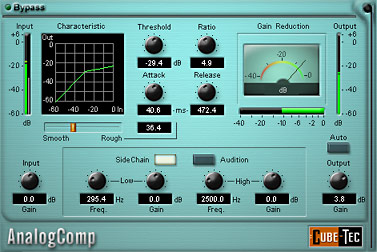
A state-of-the-art VPI offering dynamics manipulation by employing a classic compressor interface and clearly analog transfer functions.
Sensitivity adjustments are dependent upon the incoming audio signal. Frequency dependent control of compression characteristics and automatic output gain correction make this a must for any mastering engineer's tool box.
analogEQ
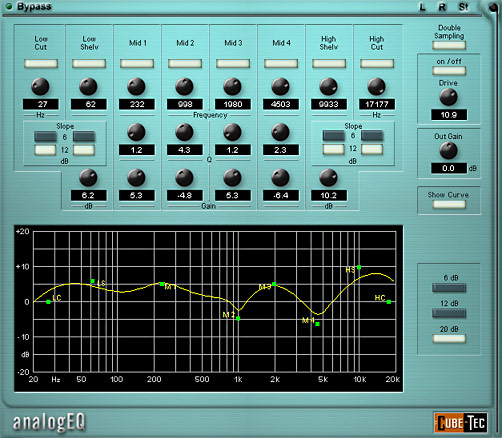
analogEQ is a 7-band equalizer that uses a completely new approach to reproduce the desired "warm" sound of analog filters - but in the digital domain.
The sound quality of a number of high quality analog equalizers were thoroughly analyzed and emulated to create analogEQ's "sound characteristic." Its built-in up-sampling system is capable of 24bit/192kHz processing, offering superb fidelity and characteristics (processing is done using 64 bit floating point). analogEQ comes with three fully parametric bands, both high and low frequency variable shelving, and flexible high-pass and low-pass filters with selectable slopes. Each frequency band can be activated independently and can be applied to the left, right, or stereo signal. An exact graphic representation of the transfer function can also be displayed. This ensures that the user maintains a clear overview, even when creating very complex filter settings.
Unlike common digital filters, analogEQ behaves exactly like an analog circuit - minus the noise - preventing any deformation of the transfer function. This even applies if a filter's operating range is identical to half the sample frequency. Adjustment ranges and phase characteristics of the analogEQ correspond to the best-quality analog equalizers, while offering the best attributes of a purely digital device. This results in the first digital equalizer that is able to compete with the best analog equalizers.
AttackDesigner
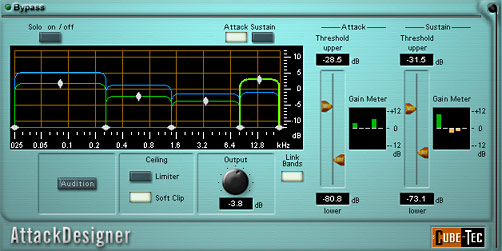
An innovative tool that allows the individual envelope shaping of transient information, for up to five separate frequency bands.
Each band's attack/release characteristics can be expanded and/or compressed dependent on its instantaneous signal level. A solo function allows the operator to "listen" to each band individually, and an audition function allows monitoring of the processed signal.
DeES
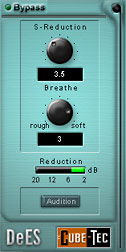
DeES defines a new level of performance in de-ess processing.
This powerful VPI performs a fully automated analysis of the incoming voice signal, recognizes its character as well as the frequency range of any excessive sibilants, and then precisely reduces them without affecting surrounding program or creating of artifacts. This process prevents any unnatural compensation of the high frequency signal components that can cause "lisping." As a result, DeES has a neutral sound character and offers effective discrete processing of the audio material without coloration, and the original character of the voice remains intact.
Operating the DeES instrument is simple and fast. The "S-Reduction" parameter defines the desired degree of sibilant reduction. Using the "Breathe" control, you can fine-tune the range affected by the VPI - from only pure "sss" sounds and transient "spicatives", to full broadband de-essing. Thanks to its adaptive analysis of sibilance, it isn't necessary to cut your film dialog into 'parts' for each different speaker. "Audition" allows you to separately monitor the removed sibilant noise, making it a snap to set-up and ensure that the program is not adversely affected.
DoubleRate
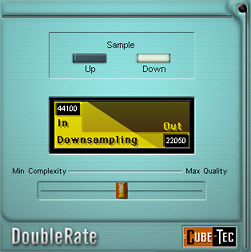
DoubleRate facilitates linear doubling or halving of the sample rate, at an unparalleled level of quality (linear phase, pass band ripple: max. 0.0000007 dB, stop band attenuation > 142 dB at f > 24,3 kHz).
This is not only beneficial for internal signal processing, but also permits masters from previous productions to be processed easily for 96kHz DVD formats. Future productions can be distributed at double the sampling frequency, whilst a master recording at half the sample rate is easily produced for the current CD format.
This makes DoubleRate the perfect bridge between the CD and DVD.
DynamicEQ
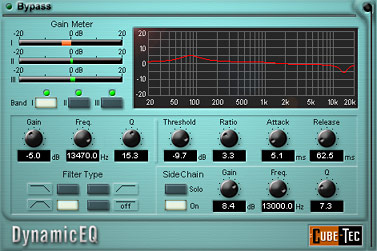
DynamicEQ provides dynamically controlled equalization within three separate frequency bands. As you adjust an EQ setting for a single band, the dynamic control analyses the degree to which these settings should be applied to the signal. It is possible to boost and cut up to 20 dB, while you can choose three different filter characteristics for each band. The dynamic stage offers the typical parameters - "threshold", "ratio", "attack" and "release" - for fine-tuning the dynamic analysis in each band. It works much like a compressor for controlling the amount of applied equalization.
An additional SideChain within the dynamic stage can be used to change the level of a dedicated frequency range within the analyzed audio signal. The "Gain Meter" displays the applied amount of equalization, while the adjusted EQ curve is visualized in the transfer function display.
The DynamicEQ can be used for multiple applications. In mastering for example, an EQ setting might only affect the quiet parts or specific instruments of a mix, while the loud areas are not affected. For restoration applications, it is possible to reduce ringing effects of old recordings without affecting softer parts without ringing. DynamicEQ can also be used for the correction of tonal imbalance on single musical instruments and voices. Intelligent De-Essing can be facilitated using different filter bands - while the first band is working very fast on sibilant peaks, a second one is running with smoother and wider settings.
FreeFilter
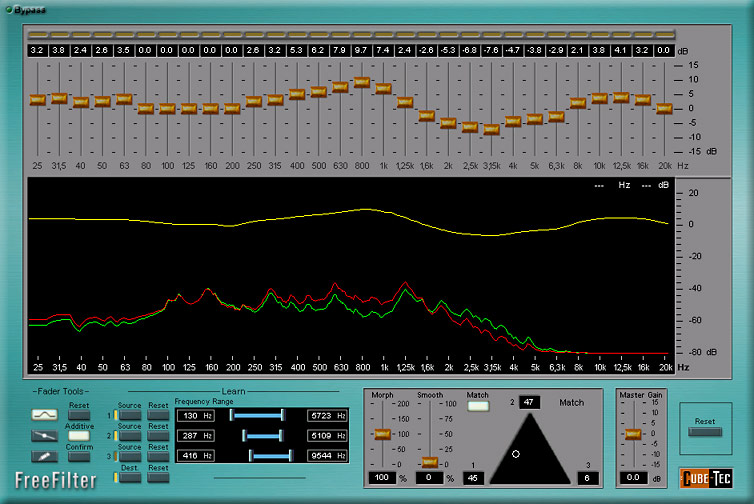
FreeFilter is a high quality linear-phase, third-octave equalizer, with a real-time display of the equalizer characteristics, and both the input and output signals.
FreeFilter is commonly used as a third octave equalizer. In addition, its integrated analyzer learns the frequency "signature" of the input signal and can create a complex filter set that may be applied to any destination signal. This facilitates the mapping of equalization and gain changes from one audio recording to another.
Differences in sound characteristics are easily visible in the real-time display and can be manually adjusted by the user. Matching the frequency characteristics of disparate mixes to create CD compilations with a uniform sound profile becomes a simple task with FreeFilter.
FreeShaper
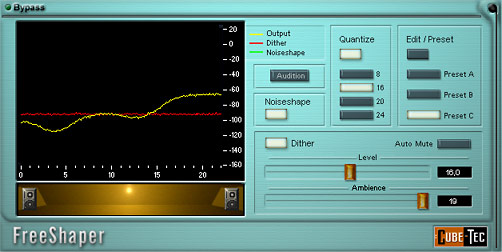
FreeShaper is a professional dithering and noise-shaping software instrument that features unparalleled power and flexibility within an intuitive interface.
FreeShaper can reduce audio word length from 32 bit floating point to 8, 16, 20 or 24 bit resolution. The amount of dithering can be user-defined using the Level parameter. The quantization distortion as well as the dither can be monitored separately using the Audition function. Added dither can be changed to a freely definable shape, and -- for the first time ever, you can freely change the width of the dither noise within the stereo panorama.
FreeShaper's large graphic display provides precise, independent control of all settings, and lets you easily visualize the output signal, dithering noise, and the frequency spectra of the noise floor. FreeShaper's flexibility facilitates the processing of all input material according to its specific characteristics, thus achieving optimal re-quantization, without granulation noise or audible coloration, with a linearity far below the least significant bit. This makes it fit perfectly with the processed audio material.
LFE Divider
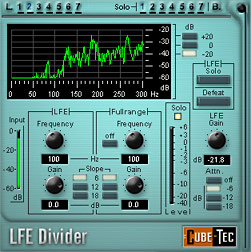
LFE Divider is a dedicated tool to extract an LFE (Low Frequency Effects) channel from a full range mix.
The LFE channel has a frequency range from 20 to 110 Hz and is used for 5.1 and 7.1 soundtracks (theatrical sound, DVD, etc.) to extend and control low frequency information. The "Frequency" control sets the upper frequency of the signal that will be fed to the LFE channel. The "Gain" control affects the amount of low frequencies from each channel that will be sent to the LFE. The "Audition" button solos the LFE, facilitating the creation of the LFE track without any guesswork.
The full-range section has several controls that can reduce the signals already assigned to the LFE, which are derived from the full-range channels. This may be necessary to avoid resonances and peaks when all full-range channels plus the LFE are active. The "Slope" for this filter can be switched between 6, 12 and 18 dB/Octave.
Loudness Maximizer
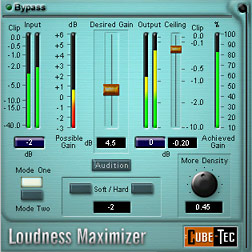
Loudness Maximizer increases the loudness, even when processing a full-scale audio signal, without creating any perceptible processing artifacts.
Using psycho-acoustic masking techniques, the Loudness Maximizer transparently increases program loudness while "hiding" typical artifacts associated with traditional compression processes.
Loudness Maximizer is extremely simple to use: the "Possible Gain" meter displays the loudness that is inherent in the program signal. Moving the "Gain-Fader" up increases the amount of loudness at the output. An "Audition" function provides a unity gain structure through the VPI, by compensating for this increased level. This facilitates proper A/B's between processed and unprocessed audio, so that you can clearly hear the spectral differences. If you're looking for that "squashed" sound, the "Density" slider will increase loudness by compressing the audio material.
Loudness Maximizer Eight
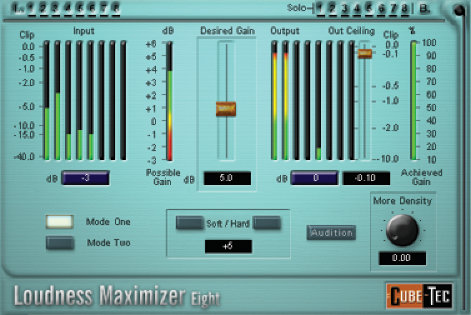
Click to enlarge
Loudness Maximizer Eight is an eight-channel surround version of the stereo VPI.
It can be linked on all eight channels for maintaining a perfect balance. Up to four linkable groups can be created. For example, you can build separate groups to control the front and surround speakers, while maintaining independent control of the LFE.
As in the stereo version, a unique audition function provides a "unity gain" structure through the VPI - facilitating parameter settings for the most transparent sound possible. This feature allows the processed and un-processed signals to be A/B'd with out the loudness increase associated with using the Loudness Maximizer. As a result, focusing on the differences in the spectral, timbral and dynamics components of the processed sound is greatly simplified.
The Loudness Maximizer is simple to use, versatile and extremely effective in the transparent gain control of surround program material at 24 bit / 96 kHz.
Magneto
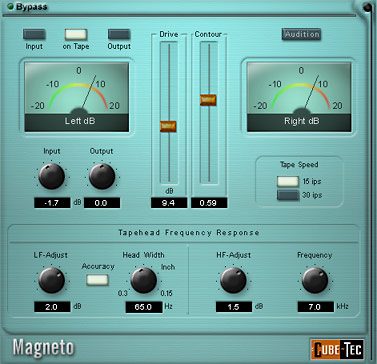
The Magneto VPI for the exact digital emulation of a professional tape machine is now available in the version 3.0.
The reproduction of the analog circuitry has been further refined so that it is now possible for the user to have a direct influence on the non-linear distortion behavior of the virtual tape machine via the 'Contour' slider.
Furthermore, the "Tape Head Frequency Response" section now offers more extensive operation possibilities: in the low frequency area, the effect of the tape head frequencies is mapped precisely via the "Accuracy" mode. Also, the size of the tape head width can be set via "Head Width". The level of enhancement / attenuation of the resulting frequencies can be determined with the "LF-Adjust" slider. In the high frequency area it is now also possible to define the edge frequency, the "Frequency" parameter, from where the enhancement / attenuation "HF-Ajust" is applied.
Besides the "Drive" slider for the amount of tape compression, there are the established functions such as "Tape Speed", switching between 15 and 30 ips, as well as "Audition" for the loudness corrected bypass switching. The functionality of this outstanding tool creates an impressively warm sound characteristic for digital recordings.
MultiComp
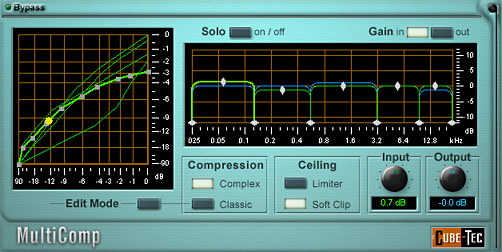
MultiComp offers extremely precise and powerful control over the dynamics of up to five different frequency bands. This permits a mastering engineer to easily "segment" a mix into its various components with unprecedented control and fidelity.
Each frequency band can be processed and monitored independently - individual bands may be soloed, providing perfect control over every parameter. Fine tailoring of each bands' compression characteristic makes it ideal for single instrument control as well as an entire final mix.
MultiComp operates in two basic modes: the 'Classic' mode with standard controls for attack and release times and the 'Complex' mode with adaptive controls and multi-segment transfer functions. In both cases, parameters can be set separately for each individual band, making it easy to avoid 'pumping' effects associated with traditional compressors.
Transfer function curves can be edited by simply dragging on the user defined "breakpoints" in each band's display. Attack and release parameters, as well as each compressor's characteristic can be set either separately or for all bands simultaneously. The Limiter or SoftClipper (user activated) prevents unwanted clipping.
MultiShuffler
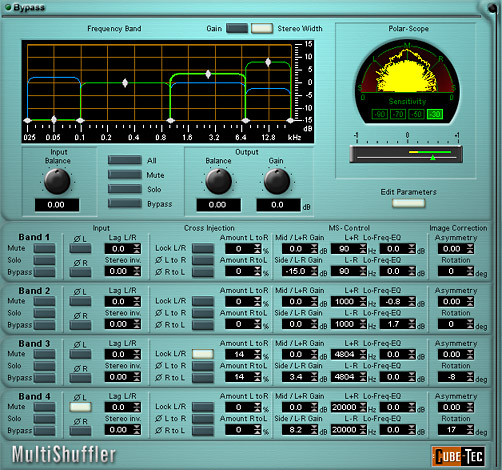
A multi-band version of the StereoShuffler, this VPI allows individual control over numerous parameters that affect spatial imaging and depth of your program.
Up to six frequency bands can be individually defined and controlled, allowing you to manipulate stereo width, center strength, phase, inter-channel delay, inter-channel insertion, filtering, etc., individually for each of those bands.
MultiShuffler is also able to create enhanced stereo program from stereo sources, or pseudo-stereo output from mono program.
PitchBandit
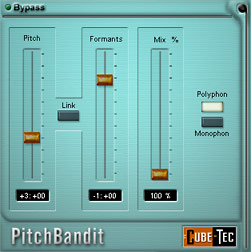
PitchBandit is a real-time "time-domain" based pitch shifter. It is intended for changing the pitch of a human voice or a single monophonic instrument while maintaining its natural character. But it also can be used to change the character of a voice without changing the pitch.
Conventional pitch shift algorithms do not reflect the fact that as an instrument or voice changes pitch, generally, only the fundamental oscillation or vibration changes. The environment where that tone was generated stays the same and therefore so does much of the harmonic structure. PitchBandit takes this in account and corrects the formants of the note retaining the resonant body of the shifted note.
PitchBandit has two independent controls, one for pitch-shift and one for formants. They can be modified independently or linked together - including linked offsets between the two controls. The "Mix" parameter facilitates the creation of harmonies to the original voice.
Spectralizer
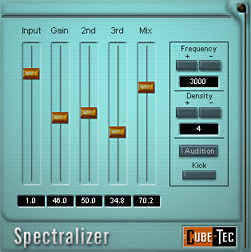
Spectralizer enhances the "transparency" of a recording without causing the side effects common to many audio enhancers.
Spectralizer utilizes a newly developed algorithm that generates the second and third harmonics of any program signal. The synthesis of the harmonically related spectrum is summed back into the program, with total user control over the pass frequencies, individual harmonic gain, mix levels and density controls. The result is a natural brilliance and shimmer not possible with traditional equalization and without the deteriorating side effects of frequency expanders and other audio enhancers.
The Spectralizer's "Kick" switch will only amplify the harmonic transients, resulting in a better presence and definition of your recording. The "Solo" switch allows you to monitor the Spectralizer generated harmonics, so you know exactly what components you are adding to your program.
This VPI is ideal for restoring "brilliance" to recordings that have lost their high frequency detail due to the effects of time, processing, media deterioration and/or the limitations of older recording techniques. you can separately monitor the added harmonics for best acoustic control.
StereoShuffler
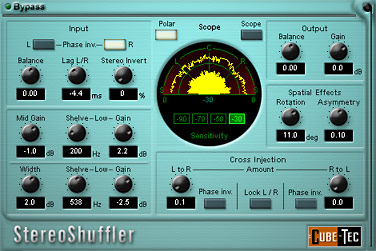
The StereoShuffler is a VPI designed for the manipulation of the stereo image.
It offers a variety of image alteration possibilities, encompassing all facets of the complex field of stereo image processing.For example, it is possible to control various parameters before or after M/S conversion. The level and frequency range of the L- R and L+ R signals can be controlled independently from one another. Special manipulations of the stereo image such as rotation and asymmetry as well as individual cross-injection of in/out-of-phase L/R signals, allow precise control over the resultant stereo image.
A dual-mode stereo scope displays the results of all manipulations. Due to the precision of the algorithms used, no undesired artifacts or phase errors will arise at any stage of the internal processing chain. Therefore, despite the significant possibilities for stereo width enhancement, the mono compatibility remains remarkably consistent.
The StereoShuffler is a powerful tool for stereo image processing and is equally adept at "narrowing" modern productions as "widening" older recordings. Special applications such as correcting "drums left/vocals right" stereo recordings from the 60's, re-aligning off-center program and manipulation of M/S recordings, make the StereoShuffler an indispensable tool in the Mastering Engineer's arsenal.
VintageComp
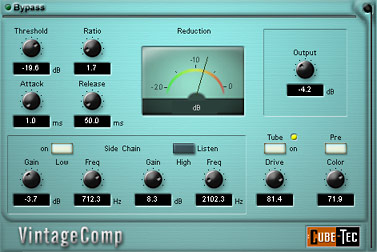
Incredibly realistic simulation of the classic tube compressor, VintageComp will give your master recordings a distinctive warmth and character without the noise or hassles of tube calibration.
Full dynamic control from soft compression to hard-knee limiting can be adjusted with master threshold, ratio-compression, attack and release controls. Low frequency and high frequency controls can be routed into the side-chain path for frequency dependent compression. For a natural sound typical valve satisfaction can be simulated.
Vitalizer
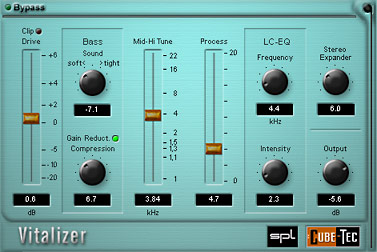
The Cube-Tec VPI version of the famous SPL Vitalizer, this is the perfect digital emulation of the world-famous processor -- psycho-acoustic equalization that increases both loudness and transparency
The Vitalizer employs a combination of real tubes, LC filters, IC technology, and multi-band compression, and is designed for use in pro recording, mastering and cutting applications. Sound processing is split into two sections: the proprietary Vitalizer circuitry and compression on the left, and the tube section on the right which can double as an ultra high quality, low noise mic preamp. If the ultimate in warmth combined with detail is needed, the Vitalizer is exactly the right tool. Recordings, both old and new, will exhibit a clarity and sweetness that may have been impossible until now. The stereo field actually becomes wider while your mixes become tighter.

